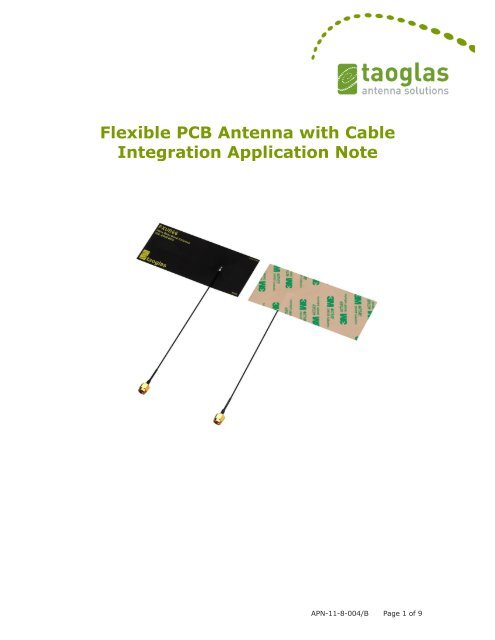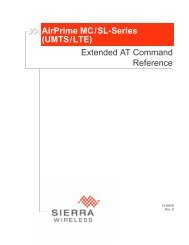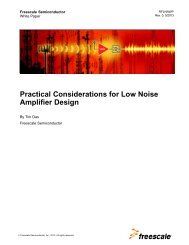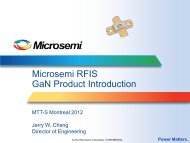Flexible PCB Antenna Application Note - Taoglas
Flexible PCB Antenna Application Note - Taoglas
Flexible PCB Antenna Application Note - Taoglas
You also want an ePaper? Increase the reach of your titles
YUMPU automatically turns print PDFs into web optimized ePapers that Google loves.
match the actual characteristic impedance of the circuit. For a cellularantenna this is most effective when tuning the antenna at over the air activetesting stage when the device is turned on and using the TRP and TISnumbers as guide to find the best impedance match for the antenna.7. BANDWIDTHBandwidth is defined as the frequency band below -10dB return loss.<strong>Taoglas</strong> <strong>PCB</strong> antennas in general are rated at a minimum of -7.5dB returnloss for the targeted application bands (for example GSM850/900/1800/1900). A return loss of below -10dB is targeted for the centreof the bands. -5dB return loss at edge of bands where it rolls off.8. VSWRIn principle the target is to be below 2.0, ideally below 1.5. In practice inmulti-band and challenging environments it may go to 3.0.9. GAINThe gain of the antenna is closely linked to the surface area or volume of theantenna. The larger the surface area or volume of the antenna, the higherthe gain. Care must be taken that clearances of minimum 4mm are keptfrom other metal components in the device or metallised substances whichwill absorb or reflect the electro-magnetic radiation, substantially reducingthe gain. The larger the clearance, the better the radiation characteristics ofthe antenna. We recommend 20mm or more for best gain and radiationefficiency.APN-11-8-004/B Page 4 of 9
10. EFFICIENCYEfficiency is a good overall measurement of an omni-directional antenna formobile communication systems such as GSM and WLAN. A <strong>PCB</strong> antenna canbe designed to have high efficiency (>30% to 50%+) if the antenna surfacearea is large enough. It is more difficult to achieve high efficiency for morethan two bands or in very compact form factor housings. Efficiency of theantenna directly relates to the TRP/TIS results of a device in OTA testing ifthe module has 50 Ohm impedance.11. POLARIZATIONPolarization describes the orientation of the wave oscillation. All our cellularand broadband antennas are linearly polarized to most efficiently match withthe signals broadcast and the antennas mounted on cellular base-stationsand from hot-spots Whether it is horizontally or vertically polarized dependsjust depends on how it is mounted from your frame of reference. Standingdirectly in front of the antenna the linear polarization is horizontal if theantenna is placed in a horizontal position and vertical if the antennas areplaced in a vertical position. In practice the radiation emitted and received byinternal antennas will be to some degree cross-polarized due to reflectionsfrom the environment and scattering in the atmosphere.APN-11-8-004/B Page 5 of 9
12. ADVANTAGES of <strong>Flexible</strong> antennaswith cableoooooooAdheres directly to inner shell of plastic housing of deviceNo space needed on main-board of deviceExtremely low profileDesign Flexibility – size, shape, cable, connector all fullycustomizable with minimum tooling costQuick turn-around time on new designs – 2 weeks to prototypesMulti-band frequencies easily accommodatedEconomical pricing13. MOUNTING<strong>Taoglas</strong> flexible <strong>PCB</strong> antennas use 3M 467 double-sided adhesive for themost reliable mounting solution. Ideally the <strong>Flexible</strong> <strong>PCB</strong> antenna is mountedclose to the outer housing of the device to allow it to radiate outwards andreceive signals without obstruction from internal components in the device.The antenna can be slid into a slot, screwed down, or affixed with doublesidedadhesive. Cable exit can be moved to different locations on theantenna. Generally the orientation of the antenna is not critical, as long asclearance to metal components is kept.APN-11-8-004/B Page 6 of 9
14. ENVIRONMENTAL CONSIDERATIONSClose proximity to components or housing affects the electrical performanceof all antennas. When placed on a non-conductive area of the board, in mostcases ideally there should be clearance of 20mm in all directions from theboard/housing for maximum efficiency. A reduction in the efficiency of theantenna efficiency and shift in tuned frequency will be observed if theseclearances are not adhered to. Proximity effects will also have an adverseeffect on the radiation pattern of the antenna. Device housings should neverbe metal or have metal materials15. TUNINGThe frequencies of <strong>Flexible</strong> <strong>PCB</strong> antennas with cable are easily shifted whenclose to other components or even if the cable is bent more than 30 degrees.This phenomenon is called “detuning”. We offer <strong>Flexible</strong> <strong>PCB</strong> antennasamples to customers on the understanding that they be tested outside thedevice as a benchmark performance. The actual production antenna will becustomized for each customer.This is why <strong>Taoglas</strong> always offers a tuning service to it’s customers atprototype integration phase. We “tune” the antenna frequency back to theright bands for the application at our lab. Samples are sent back to thecustomer within 2 weeks of receiving the device along with a test reportshowing antenna performance Return Loss/VSWR, Gain and RadiationCharacteristics, in the customer device. Please contact us for costing for thisservice. sales@taoglas.comAPN-11-8-004/B Page 7 of 9
Further services such as optimizing the RF performance of the whole deviceto enable the product to pass network approvals, regulatory compliance orspecific performance targets are offered as well.16. ISOLATIONIsolation is a measure of coupling between two different antennas. Forexample in a CDMA diversity antenna plan the target is to get -10dB isolationbetween the main and the auxiliary antenna. Greater isolation can beachieved by using different polarizations on the two antennas. For examplethe main antenna has horizontal linear polarization and the auxiliary antennahas vertical linear polarization. In practice this is difficult for Omni-directionalinternal cellular antennas as there is cross-polarization of the wavesoccurring. So the normal solution is to keep the distance from both antennasas far away as possible.The two antennas cables should not cross over or come close to the other’santenna.Testing is carried by sending a signal in one antenna and measuring thepower of the signal at the other antenna. There should be a 10dB or moredifference between the transmit and the receive signal. The easiest method isto keep moving the two antennas farther from each other until the targetisolation is achieved.APN-11-8-004/B Page 8 of 9







